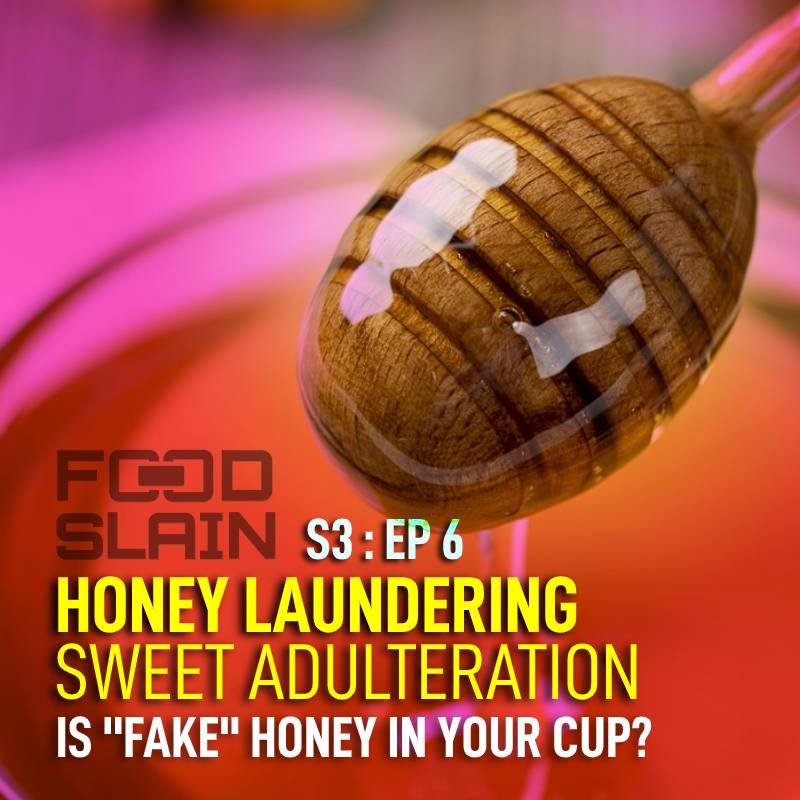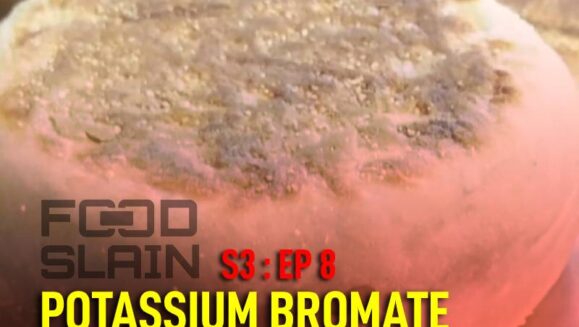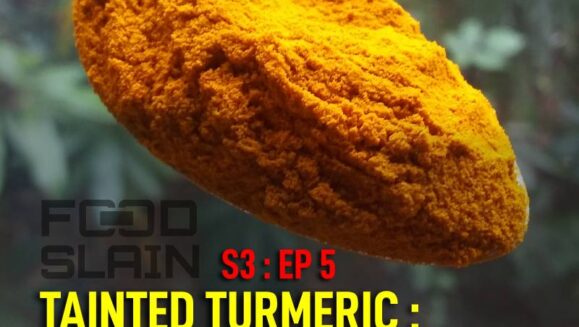In this episode, we’re talking about adulterated honey and honey laundering. And honestly, I wish this wasn’t a thing because in reality,
Buying adulterated honey is a matter of national food security. Here’s why…
Honey is the product of bees that work hard to capture pollen and nectar from a variety of flowers all spring and summer long, so that they can feed all the workers in the colony during the winter. And we reap the generous (delicious and healthy) reward of their work. Not just when it comes to honey, but for all pollinated fruits and vegetables – from blueberries, raspberries, blackberries, to almonds, apples, pears and even broccoli.
Our national food security is dependent on our ability to feed ourselves.
If we don’t take care of our bees and beekeepers, we open ourselves up to a plethora of food supply threats and shortages.
The problems we are facing with adulterated honey go like this… The US is importing large volumes of low-cost honey from overseas, the country of origin labeling rules for honey are lax and barely non-existent, labeling at the consumer level allows companies to label honey as US Grade A when it isn’t, so there is straight up fraud and many cheaters in the industry that are not only laundering honey by moving fake products from one country to another to avoid detection, but this practice of adulterating honey is having a devastating impact on life-long beekeepers and real honey producers worldwide – with the big profits going to importers and honey retailers, not beekeepers.
So, this is a sticky issue. Not just for beekeepers, but for us, as consumers.
We’ll get into the bees and beekeepers in a moment, but the truth about honey is, there are many brands of honey out there, both little known and very well known, that are cut and adulterated with cheap grain and sugar syrups, like sugar cane, corn and rice syrup, and beet sugar. In many cases these other sweeteners go undetected and end up in your cup of tea.
The cold, hard truth is, there’s fraud happening, honey buns. And it’s happening around the world. It is particularly egregious in Australia. However, for all my listeners down “unda” – you’re not the only ones. And the impact isn’t just economic, there are health implications, as well as environmental ones that we just don’t think about when we buy honey! And these things are threatening our national food security.
So, first let’s talk about the money and the market, honey.
Honey isn’t cheap. And it shouldn’t be. Bees and beekeepers work hard to produce that naturally sweet, liquid gold that is full of important nutrients like bee pollen, propolis, vitamins, minerals and enzymes. These naturally occurring enzymes, gluconic acid and hydrogen peroxide are partially responsible for the acidity of honey and help to suppress bacterial growth. Which is why honey will basically last in your kitchen cabinet…forever.
But we pay a pretty penny for honey. In fact, it’s doubled in price in the last 10 years. So, if you’re buying honey at the grocery store, you’re probably paying at least $6-$8 dollars/lb (which means for a little 12oz honey bear jar, you’re probably paying between $4-$5 for what you think is 100% pure honey.
Unfortunately, 30-35% of all honey in the global market is adulterated with something – might be corn, beet, wheat or rice syrup.
In 2018, the global production of honey was 1.9 billion tonnes of honey. The leading exporter, China, had a market share of 24%, with Turkey, Argentina and Iran close behind. The market itself was worth $387 million, which was the most profitable year on record, but since then, the market sales for honey have declined by twenty percent.
Maybe there are a lot of reasons for the decline in honey sales, and I don’t have proof of what those reasons could be, but here are some assumptions….um, maybe the fact that people are becoming more aware that honey isn’t actually 100% honey. Maybe it’s the fact that honey from the grocery store may not be as healthy as people think that honey should be…maybe.
This is where we get into the health impacts of adulterated honey.
Like I said earlier, real honey, the unadulterated stuff has properties naturally occurring in it that can be very healthy. Unfiltered honey contains things like propolis, and if you don’t know what propolis is, here is a synopsis from the US National Library of Medicine National Institutes of Health.
“Propolis is generally known as the “bee glue”, which is a generic name that refers to the resinous substance accumulated by the bees from different types of plants. The word “propolis” is derived from Greek to mean defense for “pro” and city or community for “polis”, or the beehive, in other words [6]. Propolis functions in sealing holes and cracks and for the reconstruction of the beehive. It is also used for smoothing the inner surface of the beehive, retaining the hive’s internal temperature (35°C), preventing weathering and invasion by predators. Furthermore, propolis hardens the cell wall and contributes to an aseptic internal environment. Propolis generally becomes soft and sticky upon heating [7]. It also possesses a pleasant smell. Propolis and its extracts have numerous applications in treating various diseases due to its antiseptic, anti-inflammatory, antioxidant, antibacterial, antimycotic, antifungal, antiulcer, antigenotoxic, and immunomodulatory properties.”
Propolis also contains important vitamins, such as vitamins B1, B2, B6, C, and E and useful minerals such as magnesium (Mg), calcium (Ca), potassium (K), sodium (Na), copper (Cu), zinc (Zn), manganese (Mn), and iron (Fe).
To boot, real honey also contains something called “royal jelly”, which is considered a bee superfood, and is consumed by the young larvae in the first few days of life, and also by the queen bee to help preserve her life. And Wikipedia (which I know isn’t a reliable source of information in some cases) says:
In 2010, in the United States, the Food and Drug Administration has taken legal action against companies that have used unfounded claims of health benefits to market royal jelly products. Studies made since then have found royal jelly likely to enhance collagen production,[4] vasodilation,[5] in reducing premenstrual syndrome effects,[6] and as a postmenopausal treatment in humans,[7] and against Alzheimer’s disease in animals.[8]
With all of the potential benefits of consuming 100% pure honey, we can make the leap that real honey is good for us, right?
But if it is adulterated honey, and is cut with corn syrup…is it GMO corn syrup? Probably.
If you haven’t listened to my episode on GMO corn and genetics, definitely check that out, because ANYTHING with GMO corn in it, just isn’t good for ya. If adulterated honey contains cane sugar syrup, well, that isn’t honey at all and the glycemic index of adulterated honey could be much higher, obviously if there’s cane sugar or corn syrup in it – which is not good.
To be honest, honey does have a similar glycemic index as corn syrup so from that perspective, it isn’t better, but the nutritional content of honey is much greater. Unfortunately, adulterated honey has a lot of down sides, from a health perspective. Not to mention, adulterated honey is really difficult to trace.
And that brings us to the food security, honey laundering and environmental impacts part of this episode.
Not knowing where our food is coming from poses a real food security threat. Especially if we rely on companies to be honest. We know by now, a lot of companies lean toward obfuscation. On their labels, on their websites and it just doesn’t help inform us, as consumers.
Since we’re talking about labels, Chris Hiatt, the VP of the American Honey Producers Association admits that labeling is one of honey’s biggest problems. The reality is, honey labeling laws haven’t been updated since 1985. Country of Origin labeling was updated in the 2008 Farm Bill, (which these laws hadn’t been updated since 1946 (62 years) and then implemented in 2011. According to the USDA, these laws :
Require that packaged honey bearing a
- grade mark or grade statement,
- continuous inspection mark or statement,
- sampling mark or statement, or
- any combination of marks or statements of the Department of Agriculture,
must also bear
- the countries of origin of the container of honey.
This listing of the countries of origin must be
- printed legibly and permanently,
- placed in close proximity, and of comparable size, to the certificate, mark, or statement, and
- preceded by the words ‘Product of’ or other words of similar meaning.
So, that’s the law…but here’s the problem with that.
China is the largest exporter of honey in the world and the honey they are “dumping” is being purchased by some of the largest US honey packers. Many countries in Europe have banned honey coming from a network of cooperatives in Asia because authorities have found that many Chinese beekeepers use illegal antibiotics (that have also been banned) to keep their colonies healthy. Also, many tests have detected that some of the honey coming from China has ZERO percent honey, which is um….deceptive.
But here’s where the laundering comes into play.
So, the world knows that China has been doing all these things to get their honey into the global marketplace. Since many countries realize that China is the lynchpin of adulterated honey, China will export its honey through other countries. An article I found that was explaining an investigation out of Australia describes it like this :
“Australian investigators uncovered the roots of a global conspiracy when they intercepted a large consignment of “Singapore” honey bound for the U.S. in 2002.
At the time, Singapore didn’t produce honey. The shipment was traced back to China, opening the first window into a worldwide scheme in early bloom: The industry had figured out they could launder Chinese honey through neutral countries able to ship into the U.S. without paying tariffs.”
So, that’s phase one…here’s what they do next.
“Honey brokers agree to move Chinese-origin honey to Russia, India, Indonesia, Malaysia, Mongolia, the Philippines, South Korea, Taiwan and Thailand, according to court documents.
The brokers also agreed to repackage the honey and muddy its trail by using a series of shell companies to ship it to the U.S. That meant falsifying country of origin certificates and, in some cases, deliberately mislabeling honey as molasses, fructose or glucose syrup so customs officials would not notice a suspect increase in honey shipments. Brokers were told to hire specific labs that specialized in filtering the honey to remove markers (such as pollen or soil) that could be used to trace shipments back to their true origin, according to court documents that outline the U.S. government’s case.”
The problem goes back to economics. This is an $80 million dollar fraud scheme.
There is a lot of money to be made here and this fraud has been labeled the largest food fraud in history – but that was 10 years ago. And this fraud runs deep, and it’s been going on for a long while. Try 10 years at least. So, this is concerning for a lot of reasons, right? Adulterated honey can have GMO corn syrup in it, it’s devoid of the beneficial nutrients, it can contain things like lead, banned antibiotics and other who-knows-what, AND what’s in your honey could NOT be honey at all.
Not to mention, if the imports of honey undermine the US honey industry. The honey that is being dumped is coming in for under $1/lb, as opposed to domestic honey can cost $4-$5/lb. So, if honey producers (the ones who are really caring for the bees, the ones who’s families have been doing this for generations, and the ones who keep honey bees pollinating our food crops all across the country) – if these producers cannot continue to thrive because we are importing and purchasing cheap adulterated honey…that is an issue of national food security.
Now, you know I am not a chicken little. The sky is not falling.
BUT…our honey bees are responsible for pollinating millions of acres of agricultural crops like fruits, vegetables, oil-seeds and legumes – which has the economic value of more than $20 billion annually. So when you think about your next meal, how much of that meal is made up of fruits, vegetables, oil seeds (like soybean, canola, sunflower and safflower oil) and legumes? And how much of these crops feed livestock?
Think about it…if we lose honey bees, we have a threat to our food security…which is a threat to our national security. Listen to this episode to learn more about what YOU can do. Also, share it with someone you love. Remember, to eat clean, eat healthy and love your food, and I’ll see you on the other side of the plate. Chow.



